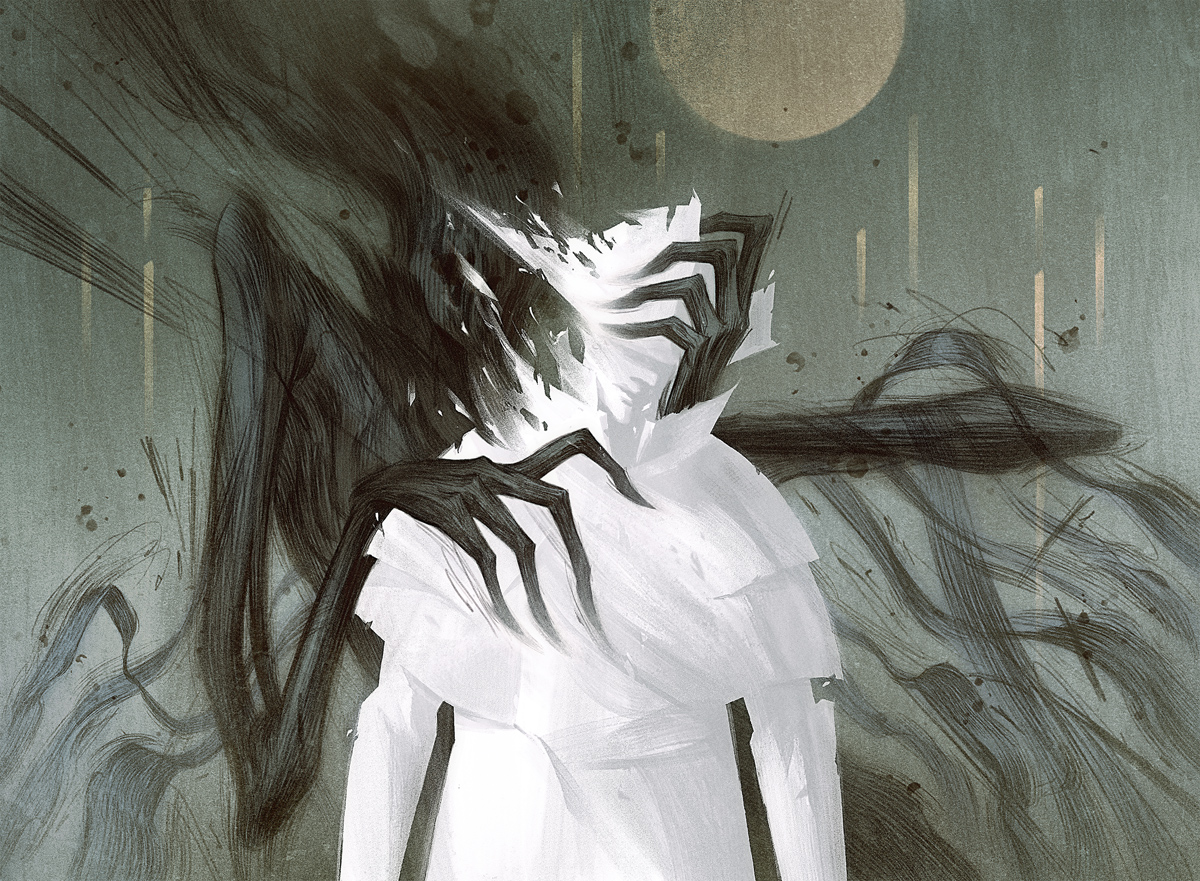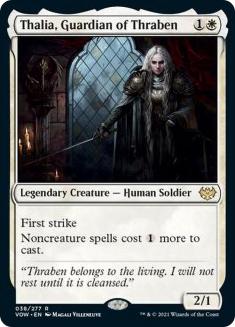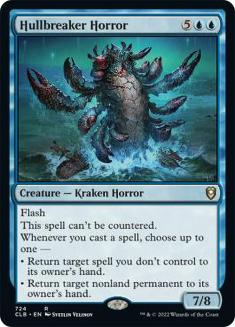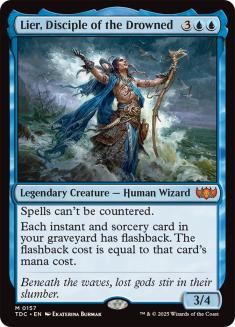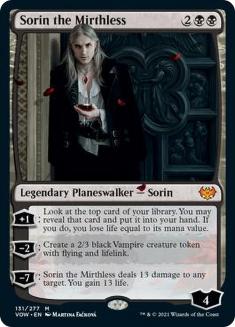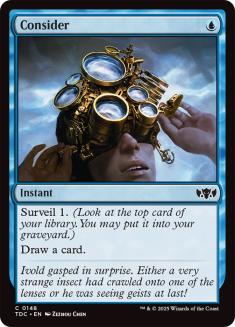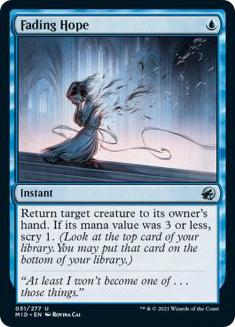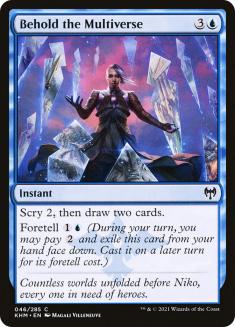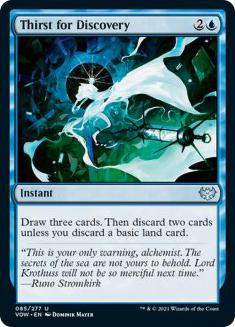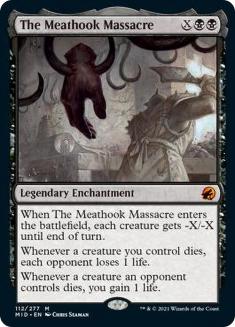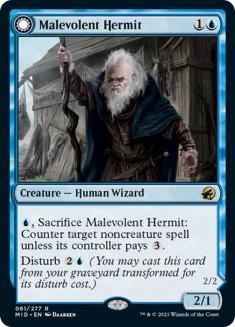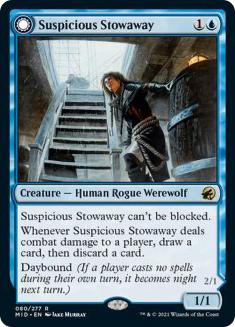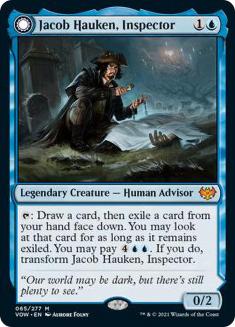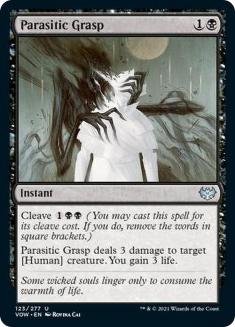Innistrad: Crimson Vow has been unleashed to the competitive world, prompting a new wave of fresh, competitive decks. I am just kidding, of course. The metagame appears to have changed very little, with one obvious exception. Mono-White Aggro❄ has risen to the top of the metagame ladder, competing head-to-head with Izzet Control / Epiphany for the crown.
Since she was previewed, Thalia, Guardian of Thraben has been the villain in my night terrors. Predicting her impact on the metagame was easy, since Mono-White Aggro❄ was already strong without her. It lagged behind Mono-Green Aggro❄ and Izzet Epiphany in popularity, even though it may have been the superior aggro option. With Thalia in the picture, it is not even close. Mono-White Aggro will be the aggressive deck of choice for anyone who wants to make life tough for Izzet pilots, while also making me miserable regardless of my deck choice.
Thalia was a problem then for control players and that issue has been amplified by current deckbuilding restrictions. I would love to play ten cheap, targeted removal spells; however, Izzet decks prevent that from ever being a reality. To remain competitive with the blue-based decks, control must keep the maindeck removal count to a reasonably low level, making the battleground ripe for a Thalia strategy. The list I am presenting today is playing the maximum amount of removal that I am comfortable playing in Standard, unless Mono-White Aggro❄ (or aggro in general) whittles away at the dominance of Izzet decks.
At this early stage of the new metagame, it is difficult to determine which flavor of Izzet is the best. I saw discussions and rumors that Hullbreaker Horror has completely wiped out the need for Alrund’s Epiphany, but I still see folks winning in their extra turns.
I happen to agree that Hullbreaker Horror is the better vantage point to battle from, though that may come from my love of the card. Whenever an expensive control-breaker hits the market, I am buying. It just so happens that this one can also be built around as a dynamic win condition. It has been a while since I had a card like this in Standard and it pairs well with Lier, Disciple of the Drowned. These two creatures demand a deck full of instants and sorceries, which naturally leans toward building a control deck.
Hullbreaker Horror is not the only card that I am impressed with from the new set. My breakdown of the Top 8 control cards from Innistrad: Crimson Vow include many cards that ultimately made the cut in my first deck of the new format. I continued with Dimir Control to start, since it has the best Lier package to battle against blue mirrors.
The Duress and Go Blank combination is top-notch, especially with the addition of Hullbreaker Horror. One of the weaknesses of Dimir Control I heavily experienced at the SCG Invitational was my inability to punish Izzet Epiphany players for tapping out. If I did not have exactly Lier that turn, my opponents went consequence-free for putting their shields down. With this version of Dimir Control, that will no longer be the case.
Creatures (4)
Planeswalkers (2)
Lands (25)
Spells (29)

Dimir Control moves from a significant underdog in the blue mirror to about dead even with the adjustments. In addition to Lier, the new win conditions are devastating upon resolution.
Hullbreaker Horror needs little commentary, as it has everything one could possibly want in a win condition. It has flash, cannot be countered, and is cannot be killed with one instant available. If all that were not strong enough, it turns every instant in your deck into a Divide by Zero, essentially ending the game with moderate hand strength. As it performs all the tasks that control players dream of, it is a 7/8 that flattens the opponent in a few turns. The seven-mana drawback is a joke, especially when thinking back to the silly cards I used to pay that type of mana for. I am not sure if it is outright better than Lier, but I do know that both together create an unstoppable duo.
To add more conflict in the win condition mix, Sorin the Mirthless has been outright amazing. The argument that the threat it produces lines up poorly in the metagame is not based in reality. When the opponent is dishing out removal to deal with tokens produced by a planeswalker, that opens the lane for the other win conditions to walk freely onto the battlefield without fear.
This has been the strategy for planeswalkers forever, with an attempt to protect itself, resource fight over it, and eventually playing the real win condition that the opponent now has no answer to. Sorin does this on its worst day and is a continued source of pressure/advantage on its best. This is another play that punishes the Izzet Epiphany/Control player for having very few counterspells and often needing to spend its Turn 3 on an Expressive Iteration. Not only does it bring the pain for the blue decks, it also has been an essential must-answer for aggro decks.
Sorin produces a creature with three toughness, lifelink, and flying, giving it anti-aggro application. Planeswalkers are naturally good against control decks, as they all typically produce advantage and are not threatened by combat damage there. Against aggro decks, planeswalkers must create roadblocks to assist the life total and gaining control of the battlefield. Sorin does all this very well, giving it two spots in the maindeck right off the bat. I hope I can find another spot for it eventually, but this build has structural requirements to keep Lier and Hullbreaker Horror strong.
The Hullbreaker Horror world has adopted Consider, but not to the extent that some thought. I knew it would be tough to find room for four copies and that would only happen if Fading Hope was cut altogether. With 28 slots dedicated to mana sources, the remaining spell slots have some heavy competition in the final stages of deckbuilding.
Fading Hope is one of those cards I love cutting, since I have never been a fan of Unsummon effects in control decks. The reason it is there at all is because of Lier, as it is one of the strongest cards to have leftover in the graveyard when he resolves.
At the SCG Invitational, the four in my deck felt awful and it was one of the peer-pressure modifications I made at the last moment. I went 4-0 against Mono-Green Aggro❄, where Unsummon is good, but was heavily punished in my multiple losses to the blue mirrors when I drew multiple copies. Many of the matches against Mono-Green Aggro❄ were so lopsided, the Fading Hope count had limited impact; however, I understood why people played so many. With this version of Dimir Control, I corrected the one-mana blue spell count, and it has worked well.
Some other big changes took place after the new cards were released. I completely cut Behold the Multiverse in favor of Thirst for Discovery. I did this for a few reasons, most important among them the mana cost. Although Behold the Multiverse could come in after a foretell investment for two mana, Thirst for Discovery is always reasonably costed at three mana.
The basic land count in Dimir Control is at a healthy ten, with limited modifications made from the original manabase. The only thing I added was a Port of Karfell, which should have been in the original version. Now that Dimir Control has another juggernaut of a creature, it is a no-brainer to add a land that could bring it back to life. With the ten basics, Thirst for Discovery often ends with one of them discarded, resulting in clean card advantage. When a basic land doesn’t appear, I often pitch some worthless cards that did not line up well in the matchup, which also feels great.
The last main deck change was the addition of The Meathook Massacre. This is another card that should have been included in the inaugural version, but I feared its lack of synergy with Lier. It turns out that busted cards need no other interaction, and it is leaps and bounds better than a maindeck Crippling Fear. The Meathook Massacre has been a consistently powerful card for me since its release and it was criminal not to include it from the jump. Not only does it earn a maindeck spot, a second is in the sideboard for good measure. In a world full of green and white monsters (especially Thalia), The Meathook Massacre is king.
The sideboard for Dimir Control went through some heavy changes as well. The last piece of peer pressure that negatively influenced by card choices at the SCG Invitational was the obsession with Malevolent Hermit. I think the card is decent, often splitting time with other anti-blue sideboard options, but the world became dependent on it. Every blue deck had four in the sideboard, so I followed suit, assuming I made a mistake undervaluing it.
After playing it in a live, competitive tournament, it became clear that my gut feeling was correct. Malevolent Hermit is decent, but not as good as other blue options that we already had access to before the release of Innistrad: Crimson Vow. Suspicious Stowaway is the superior anti-blue sideboard card, requiring an immediate answer or the game is over. It does not have the resiliency of Malevolent Hermit, but who cares? If Suspicious Stowaway hits the opponent a few times in its flipped form, they can kiss the game goodbye. If anyone has ever been on the receiving end of a creature with Curiosity on it, they completely understand. For my boomer control family out there, replace that example with Shadowmage Infiltrator, and that same, warm feeling is what you receive with Suspicious Stowaway.
To add to the unbeatable two-drops, Jacob Hauken, Inspector joins the team. It is not as broken on Turn 2 but has a game-ending ability that I had to try out. I initially had more than one copy; however, Suspicious Stowaway has commandeered those slots.
Even as a one-of, Jacob Hauken has impressed and leads to some fun shenanigans with free spells, especially when one of them happens to be one of your expensive creatures. This configuration of blue two-drops may change as the metagame shifts, since each has its own merits. Suspicious Stowaway is the most powerful play on Turn 2, where Jacob Hauken is strong in the late-game to cast initially.
If opponents are loading up with cheap removal and refuse to take any of it out, increasing the number of Malevolent Hermits may be a necessary evil. Only time will tell, but I am confident that this initial configuration is optimal for what I am currently seeing.
The last new addition to the sideboard is Parasitic Grasp. This card will only increase in number as the proportion of aggro decks continues to increase. For those who play a lot of MTG Arena, Mono-White Aggro❄ is flooding the streets ,and Parasitic Grasp is a strong card against them.
I cut the one Flunk from the sideboard for this, which was an easy swap considering what is out there. At the SCG Invitational, I had one Go Blank in the sideboard to keep my total count at four. Since I cut one from the maindeck, the number in the sideboard increased to two. It is still vital to keep all four while blue is this dominant, especially against Hullbreaker Horror. Unlike Alrund’s Epiphany, Horror cannot hide in the foretell zone, allowing Dimir Control opponents to aggressively attack the hand of the Izzet Epiphany/Control opponent.
With Hullbreaker Horror being uncounterable and Lier preventing heavy counterspell use in general, black-based control may be at its strongest point in recent history. Not only that, but I also love the way the removal lines up against the best aggro decks, making me confident with my deck choice in Innistrad: Crimson Vow Standard.

